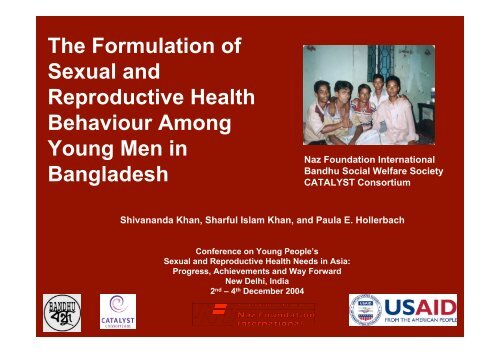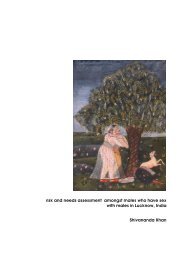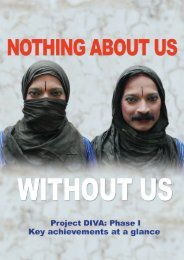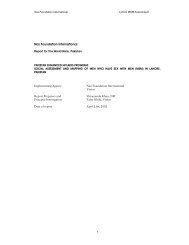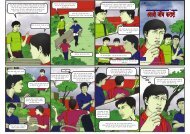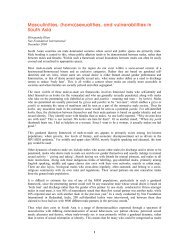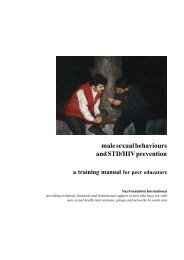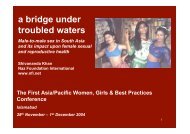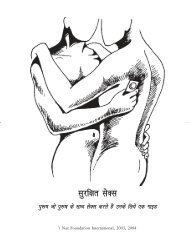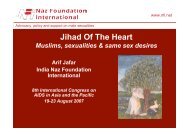Sexual Knowledge - Naz Foundation International
Sexual Knowledge - Naz Foundation International
Sexual Knowledge - Naz Foundation International
Create successful ePaper yourself
Turn your PDF publications into a flip-book with our unique Google optimized e-Paper software.
The Formulation of<br />
<strong>Sexual</strong> and<br />
Reproductive Health<br />
Behaviour Among<br />
Young Men in<br />
Bangladesh<br />
<strong>Naz</strong> <strong>Foundation</strong> <strong>International</strong><br />
Bandhu Social Welfare Society<br />
CATALYST Consortium<br />
Shivananda Khan, Sharful Islam Khan, and Paula E. Hollerbach<br />
Conference on Young People’s<br />
<strong>Sexual</strong> and Reproductive Health Needs in Asia:<br />
Progress, Achievements and Way Forward<br />
New Delhi, India<br />
2 nd – 4 th December 2004
Purpose of the Study<br />
This study was designed to:<br />
Gain insight into how young men construct their sexual<br />
attitudes and behaviours from early preadolescent<br />
years and thereafter<br />
Better understand the impact of education and recent<br />
migration to Dhaka on the construction of masculinities<br />
Examine the influential roles that socialisation agents<br />
play in constructing young men’s sexual images of<br />
themselves and others and their SRH attitudes and behaviours
Study Team
Study Area: The Thana of Demra<br />
Represented a mixed-use thana<br />
consisting of commercial<br />
interests and residential housing<br />
Access to personal networks with<br />
MSM through Bandhu Social<br />
Welfare Society<br />
Significant populations of recent<br />
migrants and literate and illiterate<br />
young men
Themes and Aspects of Masculinities and<br />
<strong>Sexual</strong>ities Explored with Young Males<br />
Gender awareness and understanding<br />
Friendship and intimacy<br />
<strong>Sexual</strong> knowledge and awareness<br />
<strong>Sexual</strong> messages<br />
Sociocultural and family expectations<br />
Sources of knowledge<br />
Impact of knowledge on sexual and<br />
reproductive behaviours
Research Methodology<br />
A purposive “snowball” sampling technique was<br />
used. Cohorts A, B, and C were subdivided by<br />
education and length of residence in Dhaka.<br />
Educational level: None to four years of<br />
education completed; five or more years of<br />
education completed<br />
Length of residence in Dhaka: Less than six<br />
months living in Dhaka (recent migrant); six<br />
months or more living in Dhaka (longer-term<br />
resident))
Cohort A<br />
Comprised of 64 boys from the general<br />
population of males (GPM)<br />
Divided into two groups aged 10-12 and 13-15 to<br />
allow grouping of respondents closer to one<br />
another in cognitive and verbal abilities and<br />
mental and emotional development<br />
Information was elicited through qualitative<br />
participatory research techniques using<br />
drawings, story telling and discussions, role<br />
playing, and body mapping.
Cohorts B and C<br />
Cohort B was comprised of 88 young<br />
men aged 16-19. Cohort C was<br />
comprised of 88 young men aged 20-<br />
24.<br />
Both cohorts were further divided into<br />
two groups, one recruited through the<br />
MSM networks (MSM) and one<br />
recruited from the general population<br />
of males (GPM).<br />
Information was elicited through<br />
lengthy focus group discussions<br />
(FGDs) and semi-structured interviews.
Socialisation Agents<br />
In addition to the sample of adolescents:<br />
20 mothers, fathers, or guardians of study<br />
respondents were interviewed.<br />
18 community leaders, religious teachers, and<br />
kobirajs (street medicine peddlers/traditional<br />
healers) participated in different FGDs.<br />
12 respondents with a variety of gendered<br />
identities and marital statuses from the MSM<br />
networks were also interviewed.
Gender Awareness and Understanding<br />
Accepted gender roles and social behaviours learned by the age of<br />
five; sex roles and expectations accepted by the age of 12.<br />
Dominant masculinity acted out among friends as active, assertive,<br />
sexually powerful, with a penetrative sexuality.<br />
Femininity is perceived in opposition to masculinity as submissive,<br />
domestic, and dependent upon significant males.<br />
Some males demonstrated a non-masculine sensitivity<br />
identified with the female, which often led to family violence,<br />
abuse, sexual violence, social exclusion, and low self-esteem.
Friendship and Intimacy<br />
Male-female relationships outside of marriage are<br />
strongly disapproved of when females begin to reach<br />
puberty. Outside the classroom, exchange of<br />
information on SRH, physical affection, and romantic<br />
love are highly restricted and often unavailable.<br />
Male-female encounters become sexually loaded with<br />
fear and curiosity; eve teasing is perceived as normal<br />
and a way in which to prove manliness to others.<br />
Girls must be virgins before marriage, since this status<br />
is associated with honour, shame, and family prestige;<br />
young men are excused because of their sexual needs.
<strong>Sexual</strong> Awareness<br />
Males and females are biologically, socially,<br />
culturally, and religiously separated by an<br />
enormous gulf in status, which often leads to<br />
clandestine relationships with females.<br />
Casual sexual encounters between male friends and<br />
between masculine and feminised males is common<br />
and tolerated despite social disapproval.<br />
For kothi/hijra-identified males, sexual awareness<br />
and knowledge arise from preadolescent sexual<br />
encounters. For other young men, early postpubertal<br />
sexual experiences are common.
<strong>Sexual</strong> <strong>Knowledge</strong><br />
<strong>Knowledge</strong> consists of myths and concerns<br />
around penile size, fears that masturbation and<br />
nocturnal emissions (nightfall) can lead to illness<br />
and are dangerous to the body; this leads to<br />
significant vulnerability and may promote risky<br />
sexual behaviours and early penetrative sex.<br />
Parents and community elders promote “good<br />
behaviours,” abstinence, and respect for elders,<br />
while friends, other socialising agents, and<br />
pornographic videos provide contradictory<br />
messages.
Table 1. Age Range and Median Age at First <strong>Sexual</strong> Experience<br />
and Sex of Partners during the Past Six Months<br />
Group<br />
Characteristics of sexual<br />
behaviour<br />
Census data<br />
Cohort C, GPM (n=9)<br />
Cohort C MSM (n=12)<br />
Pariks and married panthis<br />
(n=6)<br />
All MSM ( includes 12 kothis<br />
in Cohort C MSM, 3 married<br />
kothis , and 3 hijras ) (n=18)<br />
Age range<br />
12-17 years<br />
Median age 13<br />
Sex of recent sexual partner<br />
Male<br />
n=1<br />
Female<br />
n=8<br />
Age range<br />
7-14 years<br />
Median age 10<br />
Sex of recent sexual partner<br />
Male<br />
n=12<br />
Female<br />
n=0<br />
Age range<br />
14-19 years<br />
Median age 14<br />
Sex of recent sexual partner<br />
Male<br />
n=3<br />
Female<br />
n=3<br />
Age range<br />
7-14 years<br />
Median age 11<br />
Sex of recent sex ual partner<br />
Male<br />
n=18<br />
Female<br />
n=0
Table 2. Appropriate Age for Sex<br />
Respondent<br />
cohort<br />
Age range<br />
for boys<br />
Age range<br />
for girls<br />
Cohort B-GPM 20-22 17-18<br />
Cohort B-MSM 16-25 17-18<br />
Cohort C-GPM 18-25 18-20<br />
Cohort C-MSM 16-25 17-21
Table 3. Frequency of Condom Use<br />
Condom use<br />
Frequency of time ever users<br />
reported condom use (n=32)<br />
All the time (n=5) 15.6%<br />
Some of the time (n=14) 43.8<br />
Never (n=13) 40.6<br />
Source: Anonymous Census of <strong>Sexual</strong> Behaviours
Sources of <strong>Knowledge</strong><br />
Parents provide primarily<br />
knowledge on social and<br />
religious rules, and<br />
obligations of marriage, but<br />
they are not approached for<br />
information on sexual and<br />
reproductive health.<br />
Primary sources are older<br />
friends, pornographic<br />
videos, health magazines,<br />
and kobirajs.
<strong>Sexual</strong> Messages<br />
Pornographic videos and messages around manliness<br />
promote sexual violence and harassment where women<br />
and feminised males are viewed as sexual objects and are<br />
feared and despised; this reinforces poor self-image and<br />
vulnerability to sexual abuse and violence.<br />
Kobirajs, seen more in rural areas than in urban areas, are<br />
still important for low-income groups (less popular among<br />
the educated and middle classes); they are purveyors of<br />
inexpensive medicine and sexual advice, but their<br />
information on sexual and reproductive health still plays a<br />
significant role in perpetuating myths that are widely held.
Impact of <strong>Knowledge</strong><br />
Young men wanted accurate and explicit information on<br />
sexual and reproductive health; puberty and growing up;<br />
marriage, marital life, and birthing; nutrition and healthy<br />
living; STIs/HIV/AIDS; how to do sex properly to ensure<br />
satisfaction; masturbation, nocturnal emission, and other<br />
psychosexual concerns; and legal and religious issues<br />
around marriage, divorce, and other issues.<br />
Parents felt that their sons already knew too much about<br />
sex, but wanted them to have knowledge of marital life, its<br />
responsibilities, and STIs.<br />
Parents were unclear on the content of such health<br />
information and how it should be delivered. Mothers<br />
wanted non-visual delivery, fathers recommended NGOs<br />
and leaflets.
Policy Recommendations<br />
Collaborate with the Adolescent Reproductive<br />
Health Working Group to develop strategies,<br />
messages, and programmes around which sexual<br />
and reproductive health pilot interventions can be<br />
designed, such as school-based SRH<br />
programmes, youth help lines with confidential<br />
advice from medical personnel, and life skills<br />
curricula for out-of-school youth.<br />
Use presentation styles and mediums that are<br />
cognisant of the fears and concerns expressed<br />
by parents and other socialising agents and the<br />
social, political, and religious reality of<br />
Bangladesh.
Policy Recommendations<br />
A comprehensive programme should include<br />
information services; educational programs;<br />
awareness raising and sensitisation training for<br />
parents;referrals and access to clinical support<br />
from appropriate SRH/FP service providers and<br />
counsellors for both youth and parents; and<br />
interventions to address psychosexual concerns.<br />
Link with rural development and poverty<br />
alleviation schemes, women’s literacy and<br />
microcredit programs, as natural collaborators<br />
and partners for this holistic approach.
Policy Recommendations<br />
Organise workshops, seminars, and discussions<br />
bringing together stakeholders to address the<br />
emergent HIV/AIDS epidemic in Bangladesh by<br />
focusing on masculinity and its impact on sexual and<br />
reproductive health<br />
Support specialised counseling and treatment services<br />
for feminised males and their sex partners.<br />
STI management and treatment staff should be<br />
sensitised and trained to understand MSM health<br />
issues, provide nonjudgmental advice on medical and<br />
psychosexual concerns and follow protocols for<br />
appropriate STI screening, diagnosis, partner referral,<br />
and confidential treatment.


